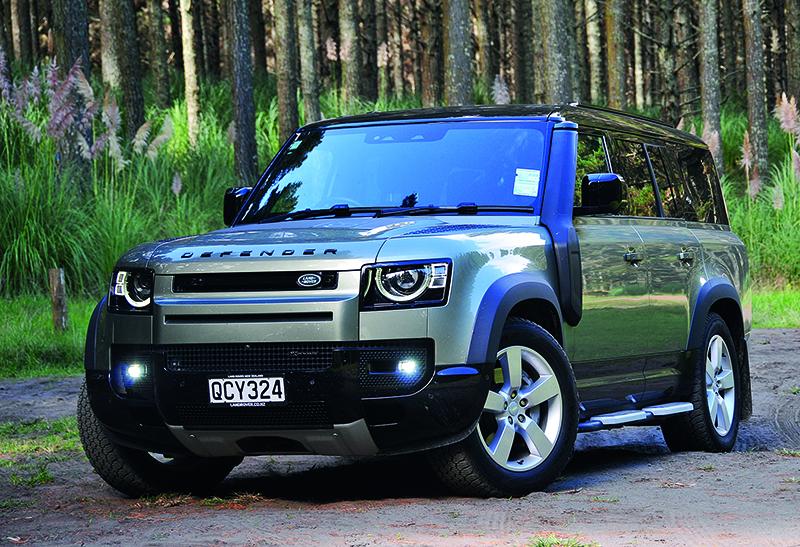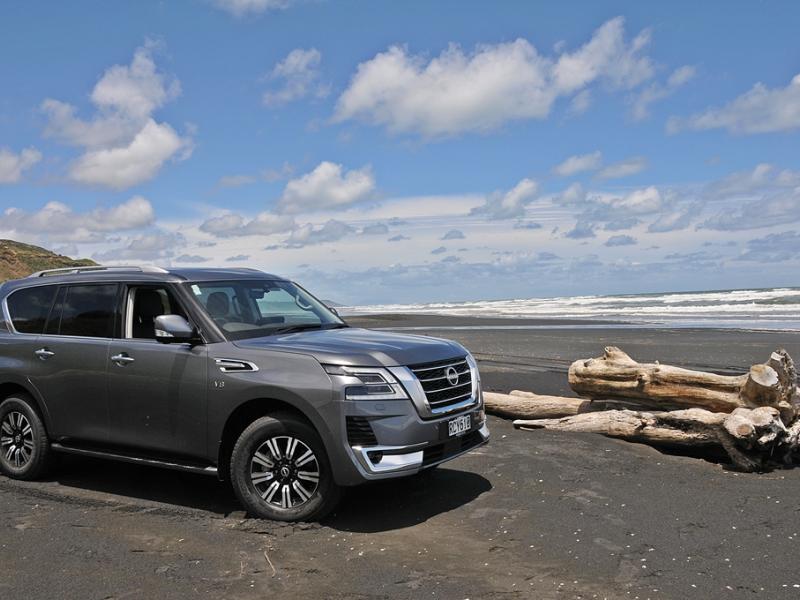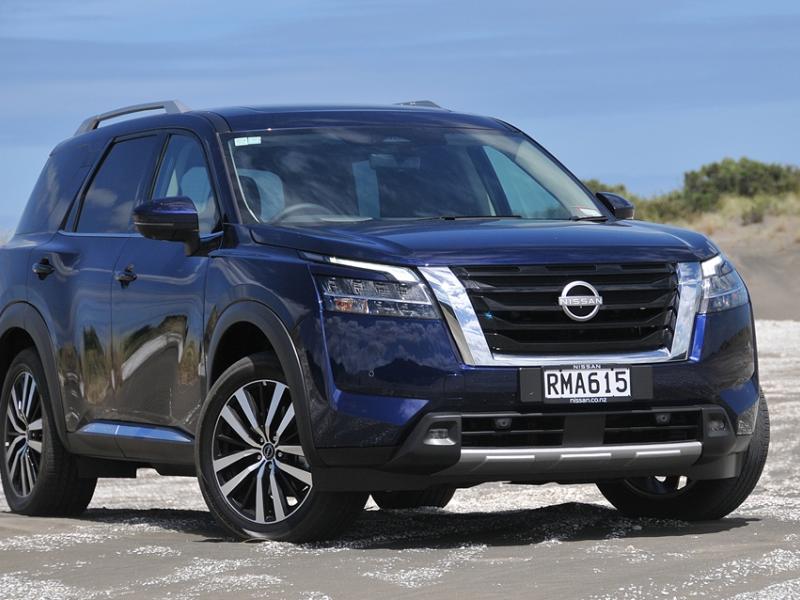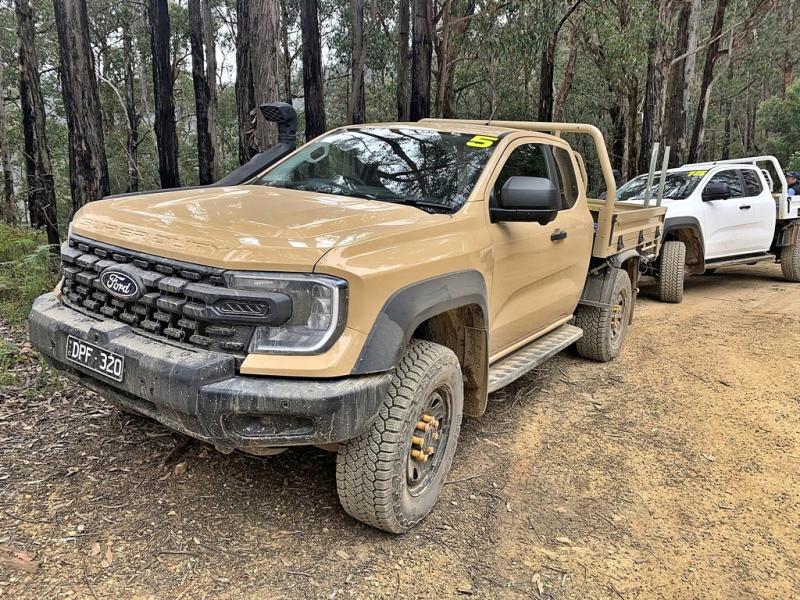Those who love ‘real’ off-roading listen up. As NZ4WD found when we named the shorter Defender our 4WD of the year, the new Defender remains a proper 4WD. This doesn’t mean living with an unrefined, clunky old truck on school or grocery runs in between those epic overland escapades. As most readers will know, Land Rover’s best-of-both-worlds 2024 Defender does what those more agricultural offerings do offroad but is equally at home on the highway or downtown.
This latest incarnation is only the fourth in over 40 years. In its new ‘90’ and ‘110’ versions the Defender emphatically left behind its agricultural origins, but the design cues are unmistakably Defender, retaining that strong flavour of go-anywhere offroad capability but cloaking it in urban smarts.
Defender still carries its boxy, practical design with unmistakeable pride. The flat front guards with aluminium tread panels, flat roof, big rear door and those Defender-only headlight clusters are a signature look, on or off the road.
Now, there’s a game-changer: alongside the existing 90 and 110 models is the 130, a proper seven or even eight-seat SUV with real offroad ability that arrived in May last year. Having an SUV this size is important for JLR in overseas markets like the USA, where it goes up against the likes of the big Chev, GMC and Ford SUVs. We Kiwis get to go along for the ride with a pair of trim specifications. Here, the rivals are Jeep Grand Cherokee, Toyota Landcruiser 300 and the Nissan Patrol.
The 130 is built on the 110 chassis, adding length to accommodate the extra passengers or cargo. It is available in New Zealand in SE trim at $155,000 and in premium HSE trim at $160,000. The SE and HSE have a 3.0-litre twin-turbo six-cylinder diesel engine, 48-volt mild hybrid system and superb eight speed ZF auto transmission.
New Zealand doesn’t get the V8 version but it’s arguably not necessary. The only big SUV available here with a V8 is Nissan’s Patrol.
The engine makes 221kW and 650Nm between 1,500 and 2,000rpm, right where it’s most useful. The full-time all-wheel-drive system includes a two-speed transfer case, and the centre differential is lockable. Top speed is 191km/h, not that we suggest finding out on Kiwi roads.
Inside, the Defender’s cabin walks the line between premium and utilitarian, with just enough design cues from the rest of the Land Rover line-up to make those familiar with the brand feel at home.
Land Rover pulls off an interesting trick inside the Defender. The cabin feels both tough and ‘expensive’ at the same time. Most buttons and switches are big and chunky, so you can easily use them with gloves on or over rough terrain. The dash-mounted gear selector is electronic, but it feels solid and moves with a satisfying, purposeful action. Every cup holder and storage surface is coated in a high-quality silicone or rubber so nothing slides around while driving.
It’s open, airy, and spacious, too, with tall upright windows that offer excellent outward visibility.
Exposed rivets in the door panels and torx-headed screws in areas like the centre console add a rugged appearance, and a magnesium beam that runs the full width of the dashboard isn’t entirely cosmetic—it’s also structural.
Painted sections of the door remind ‘those who know’ of the Defender of old and hark all the way back to the original Series 1.
Under the infotainment display, a trapezoid extension of the dashboard provides a place for buttons and switches for the climate-control system and driving mode. The shift lever and ignition switch are also mounted on this centre stack rather than the centre console.
That main infotainment screen is an 11.4-inch unit with Apple CarPlay and Android Auto integration. Phone connection is quick and simple, and the company’s Pivi Pro 1 connectivity portal seamlessly integrates the functions and features available. The default screen offers one-touch selection of navigation, mobile phone or media.
There are get separate climate controls and proper buttons to change the terrain mode and the height of the air suspension.
Almost every car available today has a ‘pollen filter’ to remove impurities. The Defender has an air quality sensor and CO2 sensor as well.
The info display and dash are among the clearest we have experienced and avoid the trap of designers wanting to load them with all the info at once. There’s pushback now from safety organisations against the trend to make everything touchscreen due to the distraction factor. Defender’s infoscreen ‘layering’ avoids this.
Step on the brake, hit the start button and the panoramic sunroof slides back as the engine fires. Smoked glass cuts glare and heat which is important for those of us who have ‘de-haired’.
From the driver’s seat, there is little indication that this is the longest of all the Defenders. The driving position can be set high, giving a commanding view of the road or muddy track. Land Rover’s ClearSight camera system means the rear-view mirror is a screen, eliminating any hassles when the second and third rows are occupied.
The layout is very practical. There are two seats in the front row and no option of a third jump seat. Praise be!
Then, in the middle row there’s slightly less legroom than in a 110 (around 20cm), although the seats do slide to help.
There’s space for three there. The seats fold forward to allow access into the rearmost row which also has three seats. These are best filled by younger passengers.
With all the seats in place there’s 389 litres of space, but fold the rearmost row flat and there’s 1,232 litres of space. Fold the middle row and there’s a cavernous 2,516 litres.
The four-zone air conditioning has outlets and controls in all three rows.
Outside, the lengthening has been carried out with great care, making the 130 obviously a Defender but obviously not a 110. There are some subtle differences when comparing the 130 to the smaller Defenders. Parking is the most obvious one. This SUV is just under two metres tall, just over five metres long (not including the spare wheel) and 2.1 metres wide with its boxy wing mirrors included. The numbers are: 5,358mm long (including spare wheel) 1,970mm high and with a wheelbase of 3,022mm. Compare it with the Toyota Land Cruiser 300 at 4,980mm long, or the Nissan Patrol Ti at 5,175mm. It’s large. It’s also manageable for all who are capable of parallel or angle parking.
The front bonnet has a central ‘power bulge’ and the edges are sculpted lower, giving excellent vision off road. It also features a satin-black low glare treatment and two checker plate inserts, one on each side of the bulge.
At the back, the spare tyre mounts on the rear (cargo) door and there are a pair of substantial recovery points at bumper level. The squared-off rear is very practical for load-carrying, maximising space for large square objects like furniture or even smaller whiteware. We’re not sure how many owners would subject their 130 to such indignities.
Also sitting in the boot space is the towball and its square shaft.
Our SE also came with a Land Rover air intake snorkel, subtly designed to fit into the profile of the left-side A-pillar and front guard.
The road wheels are 20-inch, clad in 255-section Goodyear Wrangler A/T tyres.
Out on the road, the size and weight of the 130 is apparent but not in any daunting way. The steering is rack-and-pinion, which gives more feedback and road feel to the driver than a recirculating ball or ‘steering box’ system. This elevated level of finger-and-palm information also means dropping or raising tyre air pressure creates an entirely different steering sensation. The air suspension can raise the vehicle up to 73mm.
Handling: the 130 has excellent road manners and remains fantastically comfortable though it’s the heftiest SUV that NZ4WD has ever tested. Electronically managed air suspension is standard on even the SE-level 130, and it’s slightly firmer than a 110’s to cope with the extra weight. This is a different world, where a premium SUV costs $150,000, has air suspension and will legally seat eight people. Where a premium SUV musters 650Nm of torque and will transport its occupants in supreme comfort to their destination at legal-limit speeds, whether that be work or play. That torque coupled with the eight-speed auto endows the biggest Defender with near-hot hatch acceleration times: try 0-100km/h in 7.5 seconds.
Pull the chunky gear lever into ‘D’ and set off, the Defender exudes an unflappable, unstoppable character. The shifter has just three options: reverse, neutral and drive, with a separate button for park that also engages the park brake. Low range is engaged using a button on the dash centre panel.
Again, like the 110 the 130 is remarkably competent off-road. There are all the standard Defender systems and abilities, including Land Rover’s excellent Terrain Response wizardry. The various TR modes adjust the traction control, diffs, gear changes and the throttle mapping to get through just about anything.
Approach angle is very good: 37.5 degrees. Ramp-over is 27.8 degrees. Departure angle is 28.5 degrees – the Defender 110 has a 40-degree departure angle. The 130’s departure angle is compromised due to the added length, but few owners will challenge their 130 to that extent. Anyone going far enough off the beaten path for such things to matter isn’t doing so in an eight-seat SUV with five or six children on-board. So little is lost by the Defender 130’s added practicality. It’s cool to know the capability is there. Especially for those who were a bit ‘pfffft’ about a Defender that was far less analogue and far more digital than the ‘classic’.
Though traditionalists insist axle articulation and axle crossover are the preserve of live axled 4WDs, Defender 130 would not agree. On rutty, silty tracks down in the Waikato, the all-independent 130 was in its element even when the driver was not. Axle crossover – or its independent suspension equivalent – kept all four wheels driving forward even without the diff locks engaged.
There’s hill launch assist for those times when a climb forces a second ‘go’, and hill descent control (of course) for the other side. There are drive modes for on-road, off-road and towing and sub-modes for snow, gravel and sand.
Wading depth is 900mm, the best of anything on the Kiwi market less than a Unimog; ground clearance is 290mm.
Tow rating is 3,000kg, in-vehicle payload upwards of 700kg. Respectable for an SUV.
Conclusion:
Having experienced the Series 2 (long and short), the Series 3 (a fairly ordinary Aussie import smothered in smog gear but carrying a ‘safari’ roof), the Defender 90 County (tough little turbo-diesel with a neat five speed manual transmission), we were impressed enough with the new Defender in its shorter forms to make it 4WD of the Year. As much as we like the tough go-anywhere look of the two-door 90 model, we think the four-door 110 and 130 models are more practical for most buyers.
This Defender 130 is certainly everything the shorter versions are – and more. It seats a family of eight, there’s no reasonable place it can’t go, and it has an intangible desirability that’s hard to put a price tag on. Everything from the torque-beast engine to the smooth auto, its unflappable air suspension, its fantastic interior makes the Defender feel worthy of its price.
It’s more than just a capable family hauler, something to take the kids to school with and tow your trailer. Its inherent desirability elevates the Defender 130 from just a competent, functional SUV into something special. Two thumbs up.
Highlights:
• A superb blend of clever design, well-executed engineering and world-class tech.
• There are still only a few places on earth the Defender can’t go.
• Off-road capability doesn’t compromise on-road refinement.
• More cargo space than ever.
• Evocative retro-modern interior.
• Exterior styling, tough and businesslike.






